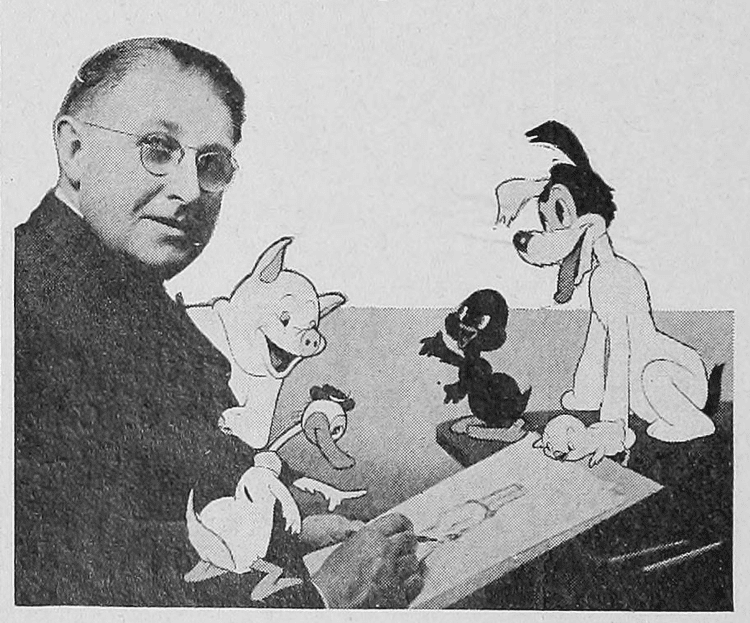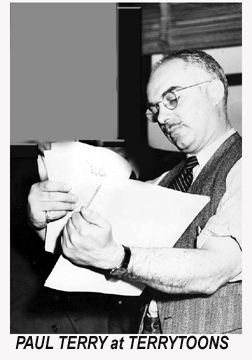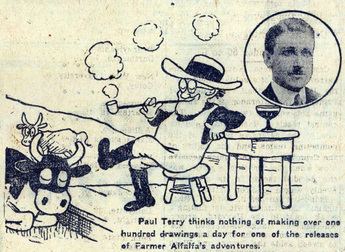Years active 1915–1955 Siblings John Terry Spouse Irma Terry (m. ?–1969) | Role Cartoonist Name Paul Terry | |
 | ||
Full Name Paul Houlton Terry Died October 25, 1971, New York City, New York, United States Movies Dinner Time, Farmer Al Falfa Sees New York Nominations Academy Award for Best Short Film (Animated) Similar People John Randolph Bray, Gene Deitch, Joseph Barbera, Alan Oppenheimer | ||
mouse s bride farmer gray silent cartoon by paul terry 1928
Paul Houlton Terry (February 19, 1887 – October 25, 1971) was an American cartoonist, screenwriter, film director and one of the most prolific film producers in history. He produced over 1,300 cartoons between 1915 and 1955 including the many Terrytoons cartoons.
Contents
- mouse s bride farmer gray silent cartoon by paul terry 1928
- Social security in america paul terry
- Early life
- J R Bray Studios
- Paul Terry Productions
- Fables Studios
- Terrytoons
- Retirement and legacy
- Death
- References

Social security in america paul terry
Early life

Terry was raised in San Francisco and in 1904 he began working as a news photographer and began to draw cartoons for newspapers. He contributed, along with his brother, John, to a weekly comic strip about a dog titled "Alonzo" for the San Francisco Call. He later transferred to the New York Press, a newspaper in New York City.

In 1914, Terry became interested in animation after seeing Winsor McCay's Gertie the Dinosaur. While still working for the newspaper, he made his first film, Little Herman, which he completed and sold to the Thanhouser film company of New Rochelle, New York in 1915.

Later that year, he completed his second film, Down on the Phoney Farm. There is a story, perhaps apocryphal, that Terry attempted to sell his cartoon to a producer who made a small offer for the film. When Terry told him that the offer was less than his production costs, the producer supposedly replied, "I'd had paid more if you hadn't put those pictures on there!"
J. R. Bray Studios
In 1916, he began working at the J. R. Bray Studios, directing and producing a series of eleven Farmer Al Falfa films. Before the end of the year, Terry left Bray, taking the rights to Farmer Al Falfa with him.
Paul Terry Productions
In 1917, Terry formed his own production company, "Paul Terry Productions" and produced nine more animated films, including one Farmer Al Falfa film. Terry closed his studio to join the United States Army and fought in World War I.
Fables Studios
In 1920, Terry entered into a partnership with Amadee J. Van Beuren, and founded Fables Studios. During this time, he began producing a series of Aesop's Film Fables as well as new Farmer Al Falfa films under that banner. Terry experimented with sound process in a Fable Cartoon called Dinner Time after pressure from Van Beuren, released in September 1928, two months before Walt Disney's Steamboat Willie was released in November 1928.
Terry's partnership with Van Beuren lasted until 1929, when Terry and Van Beuren disagreed over the switch to producing films with sound. Terry started up the Terrytoons studio in the "K" Building in downtown New Rochelle, New York, where the Thanhouser film company, purchasers of Terry's first films, was also located. Van Beuren retained "Fables Studios" and renamed it "Van Beuren Studios".
Terrytoons
Paul Terry's Terrytoons produced a large number of animated films, including Gandy Goose, Mighty Mouse, Heckle and Jeckle, and many other lesser known characters. Theatrical distribution was at first through Educational Pictures, then, after it was acquired in 1937, through 20th Century Fox.
Paul Terry was quick to adopt techniques that simplified the animation process, but resisted "improvements" that complicated the production. He was one of the first to make use of "cel animation" including animation of separate body parts. His studio was slow to switch to synchronized sound tracks and to color. He managed to keep his studio profitable, while others went out of business. Terry was once quoted as saying, "Disney is the Tiffany of animation. I'm the Woolworth."
Retirement and legacy
Terry became the first major cartoon producer to package his old films for television. In 1955, Terry sold his animation studio and film library to CBS for $3.5 million and retired. CBS appointed Gene Deitch, who replaced the old characters with new ones such as Clint Clobber and John Doormat.
Deitch departed after three years. After Deitch's departure, Mighty Mouse and Heckle & Jeckle returned, as well as new characters such as Deputy Dawg. CBS made the Terrytoons library of films a mainstay of its Saturday morning programming and continued operating the studio making both new theatrical films and series for television until the late 1960s.
Death
Terry died on October 25, 1971 in New York City. Terry's nephew, Alex Anderson, was also an animator. Paul Terry's wife Irma preceded him in death in 1969, and daughter Patricia Terry-Leahy, who survives them, has her father's cremated remains in her North Carolina home.
